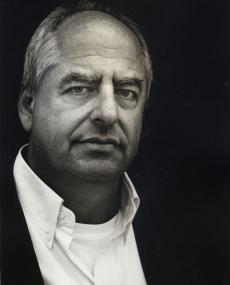
"I am interested in a political art, that is to say an art of ambiguity, contradiction, uncompleted gestures and uncertain ending - an art (and a politics) in which optimism is kept in check, and nihilism at bay."
William Kentridge was born in 1955 in Johannesburg. Son of two anti-apartheid lawyers, he learned at an early age to question structural impositions. In 1976, he attained a degree in Politics and African Studies at the University of the Witwatersrand after which he studied art at the Johannesburg Art Foundation until 1978. There, he met Dumile Feni and was greatly influenced by his drawings. He also worked as a set designer for film productions and taught design printing until he moved to Paris in 1981 to study drama at the Á‰cole Jacques LeCoq.
During the 80’s, Kentridge was art director for television series and feature films. He then began making hand-drawn animated films. Although not directly referring to the segregationist era, he acquired international recognition as a South African artist whose work tracks a personal route across the aftermath of Apartheid and Colonialism. His films are set in the over-exploited, scorched industrial and mining landscape around Johannesburg, which represent the legacy of a time of abuse and injustice.
In a talk with art critic Okwui Enzewor, Kentridge expressed, ‘Drawing is not unlike the structure and evolution of the South African landscape.’ Since 1989 he has made 9 films that accompany the end of the apartheid system, the first elections and the work of Truth and Reconciliation Commission in trying to show the complex tensions in a postcolonial memory. Amongst them are “Johannesburg, 2nd Greatest City after Paris”, “Ubu tells the Truth”, and “Steroscope”.
In addition to film and drawing, an important part of his career has been devoted to theatre. From 1975-91 he was member of the Junction Avenue Theatre Company, in Johannesburg and Soweto. In 1992, he began collaborating, as set designer, actor, and director of the Handspring Puppet Company. The Company creates multi-media pieces using puppets, live actors and animation. It performs plays like Woyzeck, Faust and King Ubu to reflect on colonialism, and human struggle between the past, modernity and ethics.
 Figure 1: Still from "Johannesburg, 2nd Greatest City After Paris” (1989). Source: www.animafest.hr
Figure 1: Still from "Johannesburg, 2nd Greatest City After Paris” (1989). Source: www.animafest.hr
 Figure 2: Puppet Drawing (2000) Collage, construction paper, tape, chalk, pins on Atlas Page.Source: www.williamkentridge.net
Figure 2: Puppet Drawing (2000) Collage, construction paper, tape, chalk, pins on Atlas Page.Source: www.williamkentridge.net
 Figure 3: Drawing for "Stereoscope"
Figure 3: Drawing for "Stereoscope"